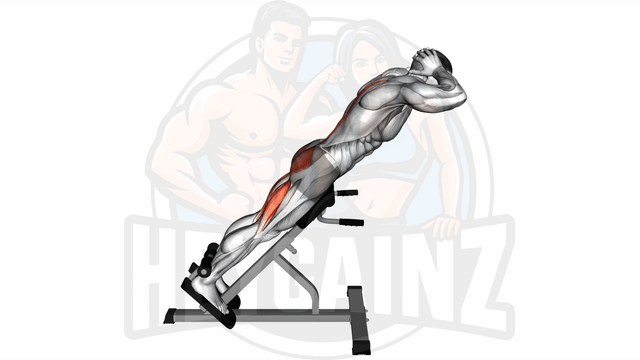
Instructions:
- 1Lie face down on a hyperextension bench, with your ankles secured under the footpads and your upper thighs resting on the larger pad.
- 2Lower your torso, bending at the waist, as far down as possible without causing discomfort.
- 3Raise your body back to the initial position using your lower back muscles while maintaining a straight back and pinched shoulder blades.
- 4Repeat the movement for the desired number of repetitions.
Tips:
- Avoid rounding your back; maintain a straight back throughout the exercise.
- Control the movement during both the lowering and lifting phases, avoiding jerky movements.
- Engage your core throughout the movement for support and stability.
- Do not rush through the repetitions, take your time to maximize muscle tension.
Understanding Hyperextensions: A Comprehensive Guide
Hyperextensions are effective exercises primarily targeting the erector spinae, the group of muscles located along the spine that play a crucial role in maintaining posture and spinal stability. This exercise focuses on strengthening the lower back and can be performed using body weight or with specific equipment such as a hyperextension bench.
For those looking to enhance their workout routine, incorporating hyperextensions can yield significant benefits, particularly for individuals aiming to improve core strength and reduce the risk of back injuries. Whether you refer to it as a hyperextension workout or simply as hyperextensions, this exercise can seamlessly fit into various training regimens.
How to Perform Hyperextensions
- Begin by positioning yourself on a hyperextension bench with your hips anchored and feet secured.
- With a neutral spine, lower your torso towards the ground until you feel a gentle stretch in your lower back.
- Engage your lower back muscles to raise your torso back to the starting position.
- Repeat for the desired number of repetitions.
Tips for Effective Hyperextensions
- Keep your movements controlled to prevent strain on your back.
- Aim for 10-15 repetitions, adjusting based on your fitness level.
- Focus on engaging your glutes and lower back throughout the movement for maximum effectiveness.
- Consider adding variations like extending your arms overhead to increase intensity.
In addition to its primary focus on the lower back, hyperextensions also engage the glutes, making it a well-rounded exercise for those looking to strengthen multiple muscle groups. However, it is essential to maintain proper form to prevent injuries, especially when incorporating advanced variations.
Conclusion
Whether you're new to fitness or a seasoned athlete, understanding the mechanics and benefits of hyperextensions can enhance your workout routine. By focusing on both form and function, hyperextensions can effectively contribute to your overall strength and well-being.